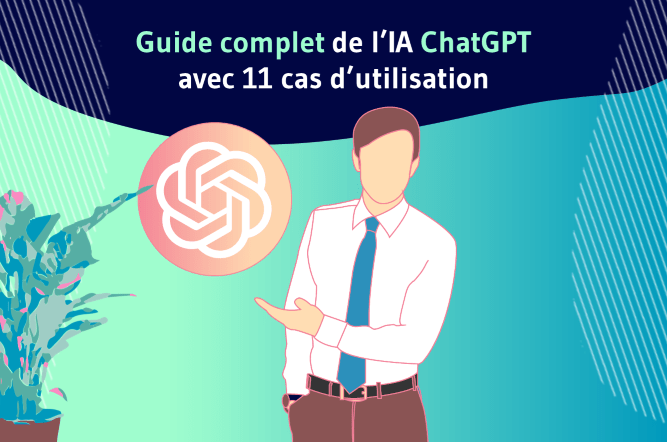
Since its release on November 30th, ChatGPT has caused a stir on the web. This revolutionary artificial intelligence has shaken up the codes by reaching one million users in just one week. 😱
Screenshots shared by users have made the rounds on social networks, propelling ChatGPT to the rank of viral phenomenon.
But beyond the hype, ChatGPT is proving to be an incredibly powerful tool, capable of performing tasks in moments that previously required hours of work.
For me, who spent a month testing ChatGPT, this is a real opportunity for our century. I discovered hidden, unsuspected features that open up new horizons.
Through this guide, I take you to discover this surprising and scary AI. I reveal its best kept secrets, and I offer you more than 11 concrete use cases to take advantage of it.
Ready to explore the endless possibilities of ChatGPT? Let’s get started!
Chapter 1: ChatGPT – What is it and why is there so much excitement about this AI?
In this section we’ll discuss the definition of ChatGPT and the secret of its success.
1.1 What is ChatGPT?
OpenAI’s mythical ChatGPT artificial intelligence is a GPT-3 variant primarily designed for chat and dialogue applications.
It is a pre-trained model that uses machine learning to generate text that resembles that of a human.
It can be refined to perform a variety of natural language processing (NLP) tasks, namely text generation, translation and question answering.
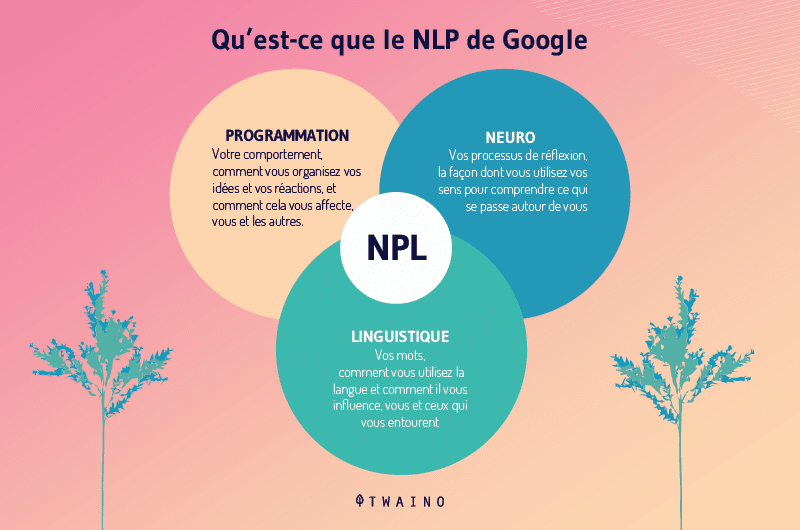
The main difference between ChatGPT and the GPT-3 model is that the former is designed specifically for conversation-related tasks, such as understanding and generating human language in the context of a conversation.
ChatGPT is therefore well suited for creating chatbots and other conversational tools that can understand and respond to natural language input in a more human-like manner.
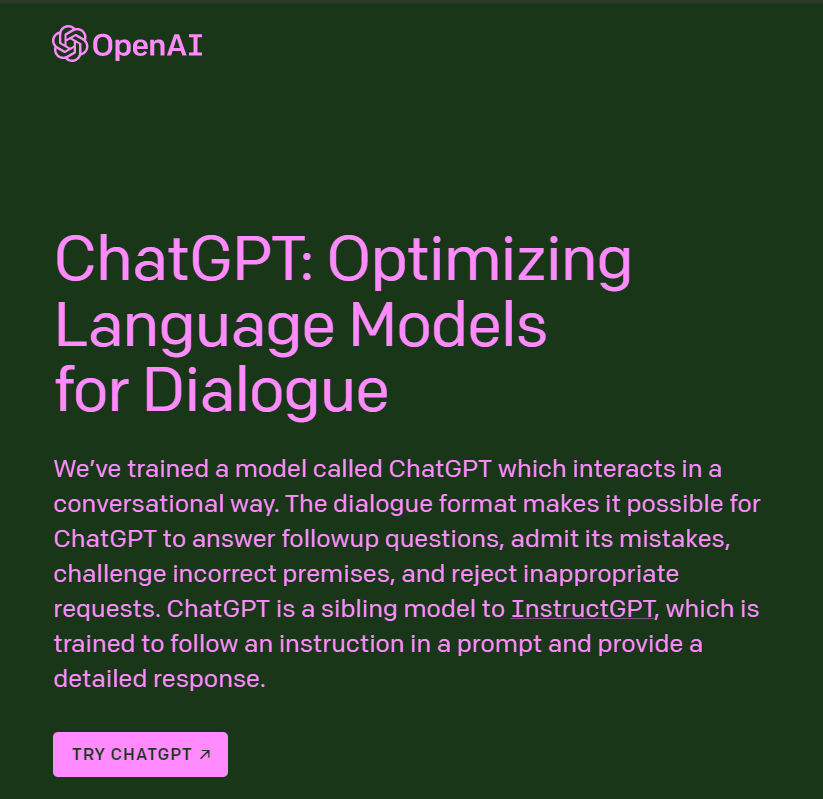
This is exactly where OpenAi’s artificial intelligence leaves its users dazed. In fact, the AI maintains conversations on any topic.
To that end, ChatGPT can be useful for applications such as customer service, personal assistance and entertainment, which rely on human-like interactions.
But that’s not all! This tool can also handle other tasks such as translation and problem solving in several areas.
In fact, it’s easy to see why some students are already using it to write their essays… before they get nailed by their teachers 😀
In other words, ChatGPT can be used for many tasks. And not to put the cart before the horse, we will discuss its use cases in depth in Chapter 3.
1.2 What is the secret to ChatGPT’s excellent performance?
ChatGPT is pre-trained on a massive text dataset using a process called unsupervised learning.
This is a type of machine learning in which the model does not receive explicit feedback or specific examples during the process in which it learns.
Instead, the model is trained on a large set of non-specific data. From this data, it is able to find patterns and relationships in the data on its own.
It should be noted that the data collected for the benefit of this conversational artificial intelligence comes from various sources such as:
- Articles;
- Books;
- Studies;
- Sites;
- And other forms of written material.
This dataset is then pre-processed and cleaned to remove any irrelevant or sensitive information.
ChatGPT was then trained on the dataset using unsupervised learning. During its training, it receives text and learns to predict the next term in a series based on the preceding words.
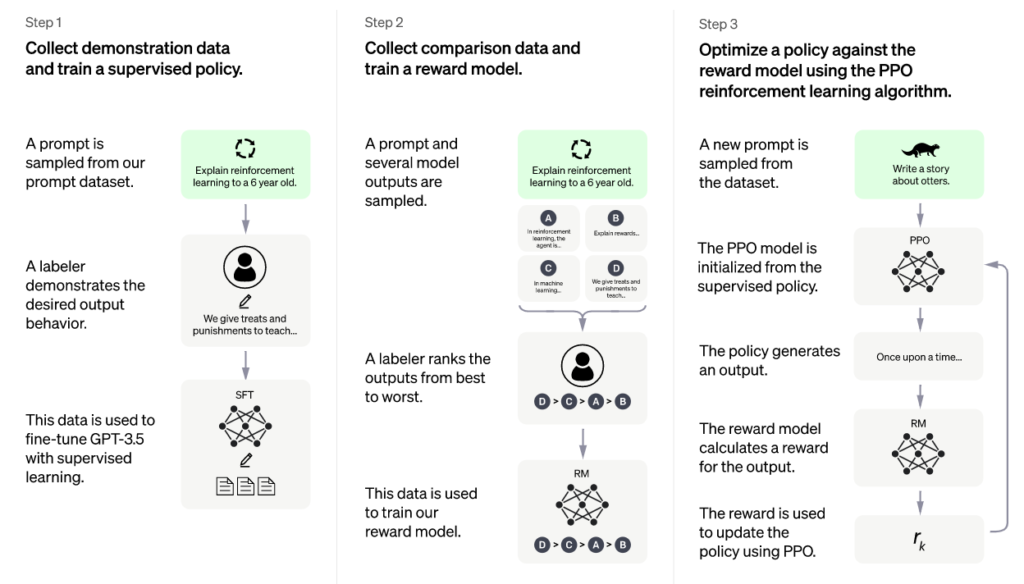
Once pre-training is complete, the model is refined to perform specific tasks such as text generation, question answering, and translation by training it on a smaller, task-specific dataset.
The model is then evaluated on a validation dataset to assess its performance and determine if further adjustments are needed.
Chapter 2: What are the features of ChatGPT?
ChatGPT offers a multitude of features that we will explore in detail in this chapter.
2.1. Natural Language Understanding
ChatGPT has the ability to understand sentences and text written or spoken in human language, with all the nuances and subtleties that come with it.
In other words, this artificial intelligence can understand sentences and texts in the same way as a human, analyzing words, phrases and contexts to extract meaning.

That said, it can understand its users’ questions and requests as well as instructions and commands.
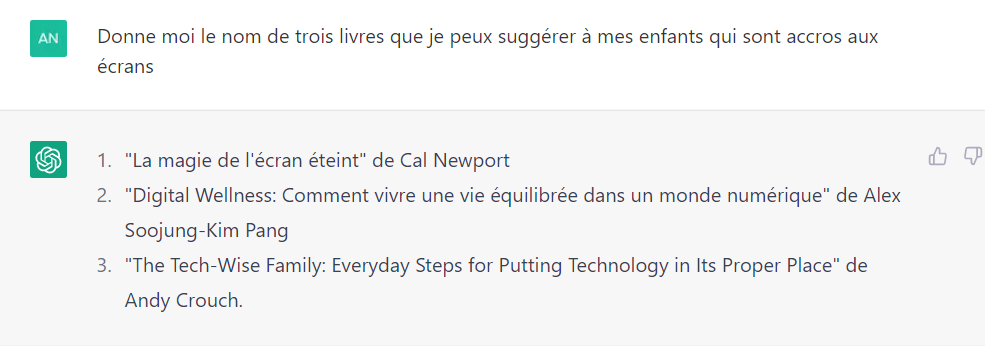
ChatGPT can also understand the contexts and implied meanings in the text, allowing it to generate appropriate responses and actions based on what it understands from the text.
2.2. text generation
ChatGPT has the ability to create text from scratch or by using prompts, templates, or data you enter. It can generate sentences and text in the same way as a human, using words, phrases and contexts to create meaning.
Specifically, depending on what is being asked, ChatGPT can generate answers to:
- Questions;
- Stories;
- Articles;
- Scripts;
- Translations;
- Summaries or summaries.
In addition, it can use prompts to generate texts in a specific style, a specific subject, with a specific tone and a specific length.
2.3. language translation
ChatGPT also offers a language translation feature based on its natural language understanding and text generation skills.

Indeed, the tool is able to translate text from one language to another while maintaining the meaning and structure of the original sentence.
It is trained to recognize language patterns in different languages. Thus, it can translate text from one language to another in the same way as a human.
So whether it’s paragraphs, sentences, articles, scripts and more, ChatGPT can handle the translation.
2.4. Sentiment analysis
Sentiment analysis is an interesting feature of ChatGPT. If we all liked to analyze our partners’ messages to know their feelings, the prospects of this feature are greater. 😊
ChatGPT has the ability to detect and evaluate the opinions, emotions and feelings that a text expresses.

It is also trained on text data corpora with sentiment annotations to learn to recognize sentiment patterns in natural language.
As a result, it can detect and evaluate expressed sentiments as a human would, including:
- Tweets;
- Blog comments;
- Product reviews;
- Etc.
This will obviously identify positive, negative or neutral opinions. It can also be used to analyze the reception of products or services, to monitor social networks, for market analysis, etc.
2.5. Text summarization
ChatGPT can extract the most important and relevant information from a text to make a summary. It can analyze words, sentences and contexts to identify the most important information in a text.
It can thus summarize:
- Articles;
- News stories;
- Reports;
- Books;
- Etc.
This feature can be used for press analysis, news research, market analysis, etc.
2.6. Dialogue
One of the most used features of this artificial intelligence since its release is dialogue.
It can maintain a fluid and natural conversation by using contextual information, previously shared knowledge and stated goals to guide the conversation.
It should be noted that ChatGPT is trained on corpora of conversation data, which allows it to recognize dialogue patterns in natural language.
Therefore, it can maintain a conversation in the same way as a human, while understanding the user’s intentions and responding appropriately.

As mentioned earlier, ChatGPT can thus maintain a conversation with users for applications such as:
- Virtual assistants;
- Chatbots;
- Conversational agents;
- Etc.
It should be noted that the tool uses prompts to guide the conversation, contextual information to understand the user’s intentions and previously shared knowledge to maintain a fluid dialogue.
2.7. Document understanding
ChatGPT also offers a document understanding feature. This is its ability to understand and extract useful information from structured or unstructured documents.
Indeed, it can perform tasks such as:
- Character recognition;
- Data extraction;
- Content recognition;
- Etc.
2.8. Command understanding
ChatGPT can understand commands or instructions given by a user in natural language and execute them appropriately.
It analyzes words, phrases and contexts to identify the most relevant information and execute it appropriately.

When integrated with connected devices and task management systems, it can understand and execute commands such as “Turn off the light,” “Set the temperature to 22 degrees,” “Add ‘apples’ to my shopping list,” etc.
Chapter 3: How to use ChatGPT AI?
While millions of people are already using ChatGPT, people are still not fully exploiting the potential of this artificial intelligence.
Building on the features we discovered earlier, in this chapter we will discuss:
- How to ask ChatGPT questions to get accurate answers?
- ChatGPT’s commands and how to use them;
- How to set up ChatGPT to get the answers you want.
3.how to ask ChatGPT questions and get accurate answers?
Like a car where you have to turn the wheel to follow the path and get to your destination, ChatGPT needs precise instructions to provide you with accurate results.
Because of its power, some would argue that we don’t need to turn the wheel in ChatGPT because it is like an autonomous vehicle. And even then, you need to enter the address of your destination to get there.

Similarly, in this section we’ll learn how to properly define your address (your questions) so that ChatGPT can take you there.
It’s about how to provide basic information to ask questions effectively and receive answers from the AI.
The first secret is to phrase a question in natural language clearly and accurately. This allows ChatGPT to understand what you want to know and provide an appropriate answer.
Second, if you want a more precise answer, it is helpful to provide context with previous sentences that can give it a better idea of what you want to know.
It’s about using prompts to give more context to his answers or to direct his response to a specific task.
You can also use parameters to control the length of the answer, the level of detail, or to include additional information.
Also, if you are not satisfied with the answer, you can rephrase your question in a different way to get a more accurate answer.
It is also important to know the specific commands ChatGPT understands to get the most accurate answers possible.
By following these steps, you should be able to ask questions effectively and receive accurate answers from the artificial intelligence.
Because the model is automated, however, there are limits to its understanding and capabilities. Therefore, there may be errors or inconsistencies in the answers, so it is important to verify the information obtained with reliable sources.
3.2 ChatGPT commands
There are many specific commands that can be used to get specific responses from this AI. These commands depend on the specific versions of ChatGPT one is using and the specific tasks one wishes to use the skills for.
3.2.1. The ChatGPT search command
There are several ways to use the search command of this AI. In general, simply ask a question or query that you want answered and use relevant keywords to indicate what you are looking for.
For example, you can ask it “What is Apple’s stock price right now?” or “Give me the latest news on COVID-19 vaccines.”
It is possible to ask ChatGPT to search for information on a specific topic using commands like “search on xyz” or “information on xyz”.
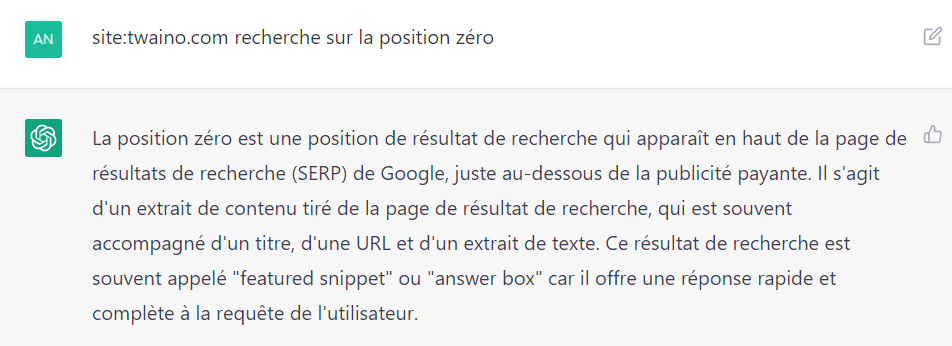
What makes this artificial intelligence even more amazing is that you can also use search operators to refine the results, such as “site:”, “filetype:”, “intitle:”, etc.
To test how this works, we’ll ask ChatGPT to do a search on what an internal link with the search operator is.
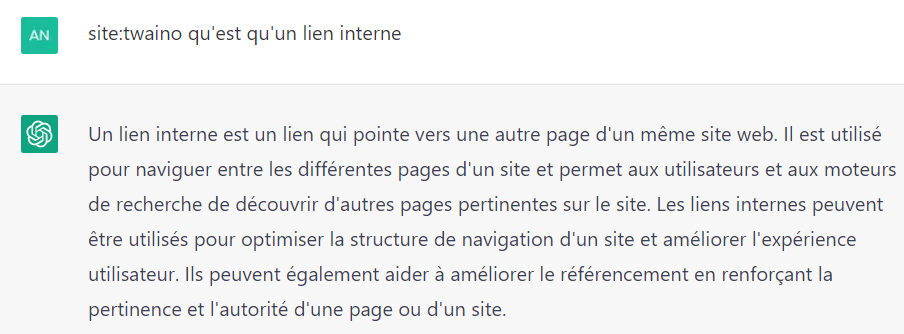
Here is the answer it generated for us:
“An internal link is a link that points to another page on the same site. It is used to navigate between different pages on a site and allows users and search engines to discover other relevant pages on the site.
Internal links can be used to optimize the navigational structure of a site and improve the user experience. They can also help improve SEO by boosting the relevance and authority of a page or site.“
To find out if this really works, we’ll paste his answer into Google to see what site he was inspired by.
And as you can see, unsurprisingly, the Google search suggested in the first position the definition of internal link that Twaino proposes on his site.
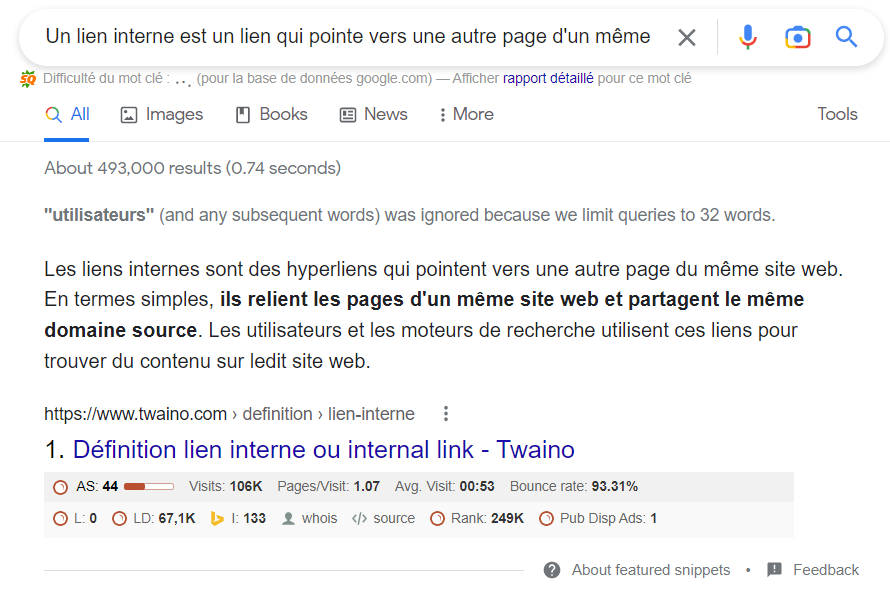
Note, however, that querying with the search operators does not always work, even if ChatGPT provides you with relevant results.
Indeed, it does not recognize some sites, so some operators will not provide results since the tool only provides text.
3.2.2. The ChatGPT calculation command
There are several ways to use ChatGPT’s calculation command. You simply submit a query that requires a mathematical calculation to get an answer.
For example, you can ask “What is the result of 2 + 2” or “Solve the equation x^ 2+2x-3 = 0.
3.2.3. The ChatGPT translation command
To use the translation command, you can give it some text to translate and specify the source and target languages.
For example, you can tell ChatGPT “Translate ‘Bonjour comment vas-tu?’ from English into French” or “Translate ‘Guten Morgen’ from German into Spanish”.
As an example, we will run the following query: “Translate the sentence ‘Because their mother is not at home, the children watch TV and don’t review their lessons’ into Spanish and German”.
As you can see, the tool generated the following answer:
- “Porque su madre no está en casa, los niños ven la televisión y no estudian sus lecciones.” (Spanish translation)
- “Weil ihre Mutter nicht zu Hause ist, sehen die Kinder fern und bereiten sich nicht auf ihre Lektionen vor.” (German translation)
3.2.4. The ChatGPT sentiment analysis command
You can use the sentiment analysis command by entering a text for which you want a sentiment analysis.
As we mentioned earlier, you can submit a movie review, a blog comment and ChatGPT will give you a sentiment analysis. This can be positive, negative or neutral.
It can also detect and evaluate the feelings expressed in a text, such as anger, sadness, joy, etc.
In order to check how well this command works, we will analyze with ChatGPT the sentiment of this comment under a LinkedIn post.
And this is what ChatGPT thinks 🙂

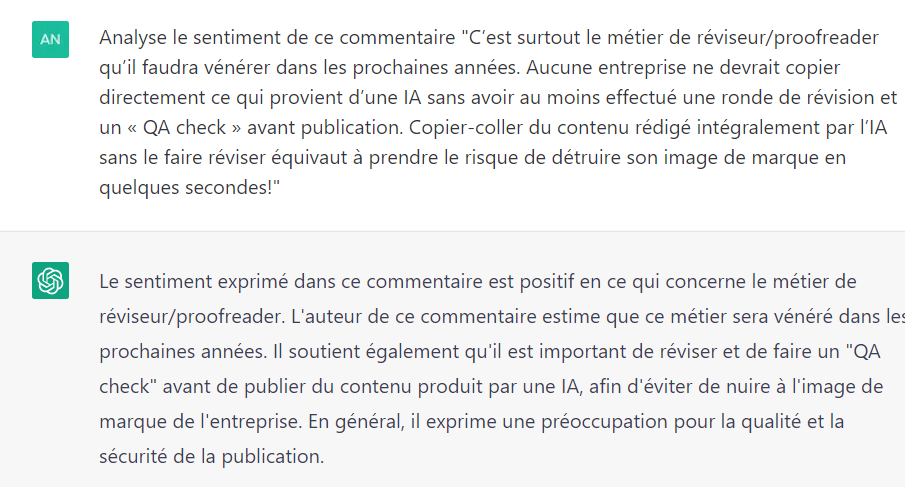
3.2.5. ChatGPT’s summarization command
To use this summarization command, you just provide it with a long text and it returns a shorter summary of that text, which contains the most important and relevant information.
You can use specific commands to instruct it on the desired length of the summary, or to ask it to highlight the most important information in a text.
As an example, we’ll ask ChatGPT to summarize a blog post about conversion rates in 200 words.
And this is what the artificial intelligence offers us:
“This text talks about optimizing the conversion rate on a website, which is measured as the percentage of visitors performing a defined action on the site.
It describes examples of desired actions such as buying a product, subscribing to a newsletter, filling out a contact form.
He explains how conversion rate can be calculated and describes optimization as a process to increase the percentage of people performing a specific action on a website that includes data analysis and usability and A/B testing.”
He can even be asked to reduce the volume of the summary to get a shorter text.
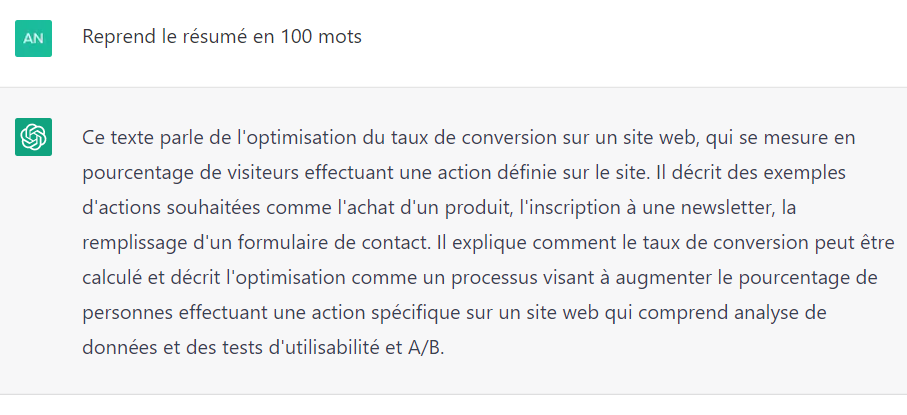
3.2.6. ChatGPT’s text and dialog generation command
You can ask ChatGPT to write a text for you by formulating your request in the following way: write me a text on “the subject of your choice.“
Alternatively, you can ask it to support a conversation by using commands like “let’s talk about xyz.”
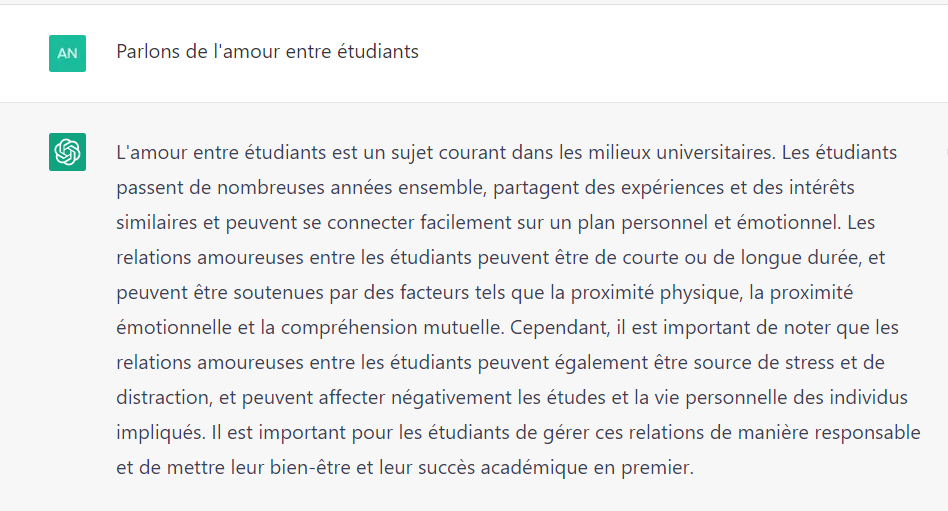
3.3. ChatGPT settings
Users can ask ChatGPT to generate text based on certain parameters such as subject, style, tone, length.” Let’s see what these parameters are.
3.3.1. The temperature parameter of ChatGPT and its use
Temperature is a parameter that controls the tone and style of the response generated by the natural language processing model.
Temperature is generally defined as a float between 0 and 1, where a lower temperature will result in more predictable and conservative responses, while a higher temperature will result in more unpredictable and creative responses.
Some examples of how temperature is used include:
● Low temperature
Temperature = 0.1
This can result in more formal and predictable answers, such as“The main causes of global warming are greenhouse gas emissions from fossil fuel use.“
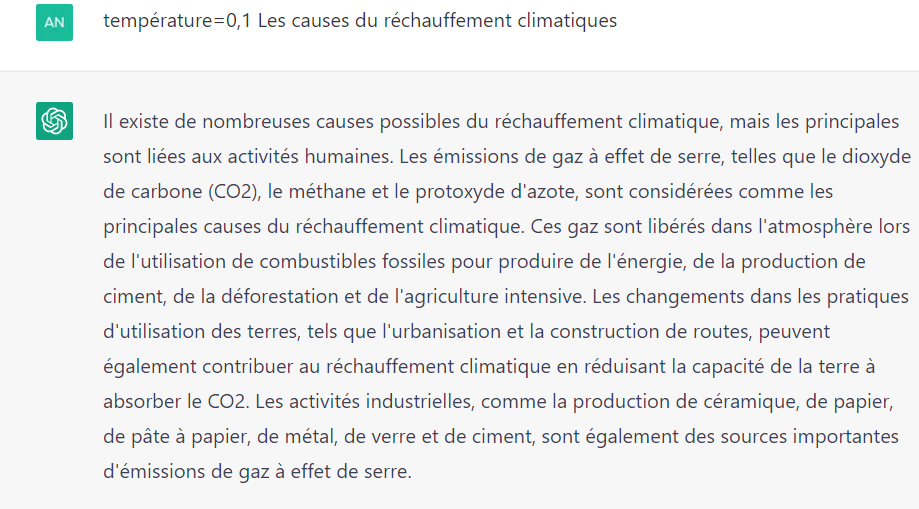
- Average temperature
Temperature = 0.5
This may result in answers that are more balanced between predictability and creativity, such as,“The main causes of global warming are greenhouse gas emissions from fossil fuel use, but there are also other factors such as deforestation and intensive agriculture.“
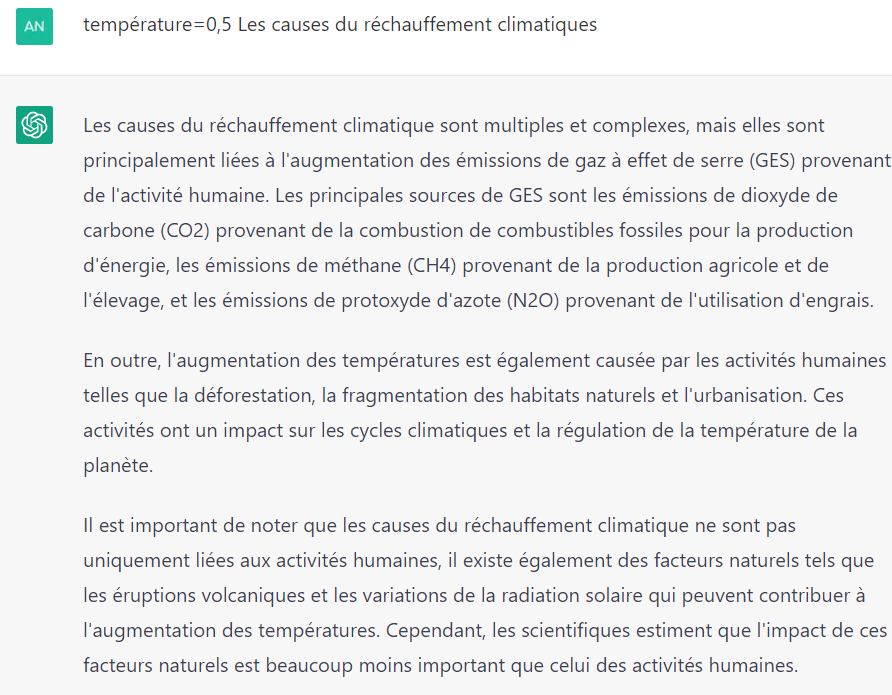
- High temperature
Temperature = 0.9
This can lead to more unpredictable and creative answers, such as“The main causes of global warming are greenhouse gas emissions from fossil fuel use, but there are also hidden factors such as cosmic rays and solar flares.“
Note, however, that a balance must be struck between the temperature of the response and the quality of the information provided.
3.3.2. The prompt parameter and its use
A prompt is a phrase or series of phrases that give more context to ChatGPT’s responses, or that direct its response to a specific task.
It can be an instruction, a question, or a phrase that gives more context about what you want the tool to do.
Prompts can be used for many tasks, such as:
- Saying what topic it should talk about to generate text;
- Saying what language it needs to translate a text into;
- Saying what information it should include in its response;
- Giving additional information about the context of a question.
Some examples of how the prompt parameter can be used are:
● Asking for clarification
prompt = “What is the capital of France?”
● Open-ended questions
prompt = “What are the benefits of meditation?”
● Provide context when generating text
prompt = “Write a short story about a robot that discovers emotions.”
3.3.3. The max_length parameter and its use
The max_length parameter is an integer that is used to limit the length of the response generated by ChatGPT. It can be used to obtain shorter responses or to ensure that the response does not exceed a certain character limit.
Here are some examples of how the max_length parameter is used:
● Limit the length of a response to 100 words
max_length = 100
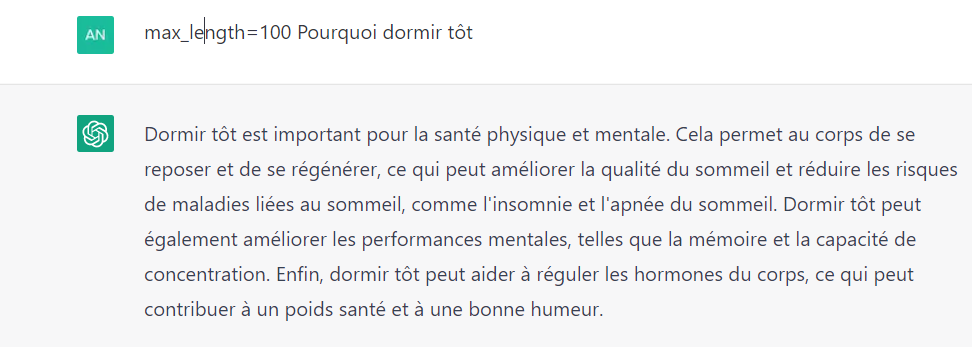
●Limit the length of a response to 500 words
max_length = 500
Think about the desired length so that the generated response does not miss important information.
3.3.4. The ChatGPT “n” parameter and its use
The “n” parameter is an integer that allows you to specify the number of responses to generate. It is often used to generate several different answers for a single question or for a single command.
This can be useful to get several different points of view on a subject or to generate different ideas for a project.
Here are some examples of how the n parameter is used:
● Generate 3 different answers for a question
n = 3
As an example, we can ask the query, “Generate three catchphrases to approach a stranger while jogging”.
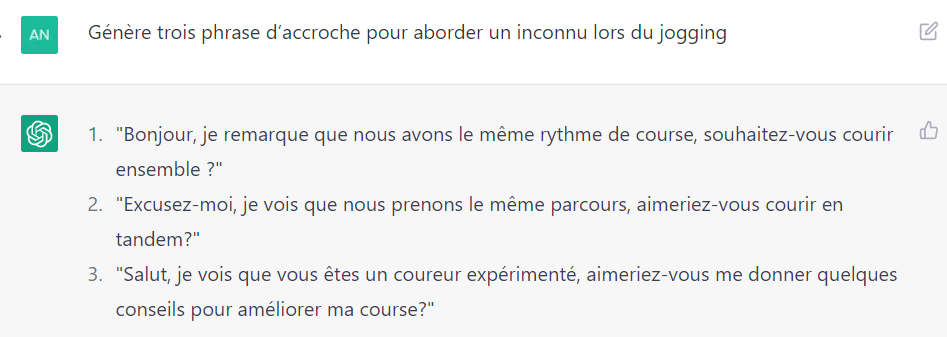
● Generate 5 different ideas for a project
n = 5
It is also important to think carefully about the number of desired responses so as not to generate unnecessary responses.
3.3.5. The ChatGPT template parameter and its use
The model parameter is used to specify which version of the artificial intelligence to use to generate responses. It is often used to use specific versions that have been trained on specific data or have specific skills.
3.4. Limitations of using ChatGPT
These are the limitations of ChatGPT’s natural language processing skills.
3.4.1. ChatGPT’s natural language processing limitations
ChatGPT may have difficulty understanding certain nuances and contexts of natural language.
Being an automatic language processing model that has been trained on textual data, it may have difficulty understanding idioms, ironies, sarcasm, which are often related to cultural knowledge.
Similarly, ChatGPT may have difficulty understanding the contexts of sentences, i.e., the information needed to understand the meaning of a sentence that is not explicitly in the sentence itself.
As a result, the AI may not fully grasp the meaning of sentences, leading to inconsistencies in the responses generated. Here is what OpenAI says about this on its blog:

3.4.2. The limits of ChatGPT’s language understanding skills
When it comes to language understanding, ChatGPT has some limitations that can affect the quality of the generated responses.
These limitations include:
● The difficulty in understanding foreign languages
Being an automatic language processing model that was trained primarily on English data, ChatGPT may have difficulty understanding and generating responses in other languages.
● Difficulty understanding dialects
Although it is able to understand different accents and dialects of the language, it may have difficulty understanding specific terms, phrases, and turns of phrase that are unique to a dialect. As a result, there may be errors in the way ChatGPT understands your queries, which may also result in incomplete responses.
● ChatGPT may also have trouble understanding the nuances of a language
Because natural language is often ambiguous and contains nuances, ChatGPT may have difficulty understanding certain nuances such as irony, sarcasm, idioms, etc.
3.4.3. ChatGPT’s limitations in semantic understanding
In terms of semantic understanding, ChatGPT may not understand the connections between words in the same sentence.
Since it was trained on textual data, it may not understand the semantic links between words in a sentence, such as verbs and objects, subjects and verbs, etc. It may also have difficulty understanding the semantic links between words in a sentence.
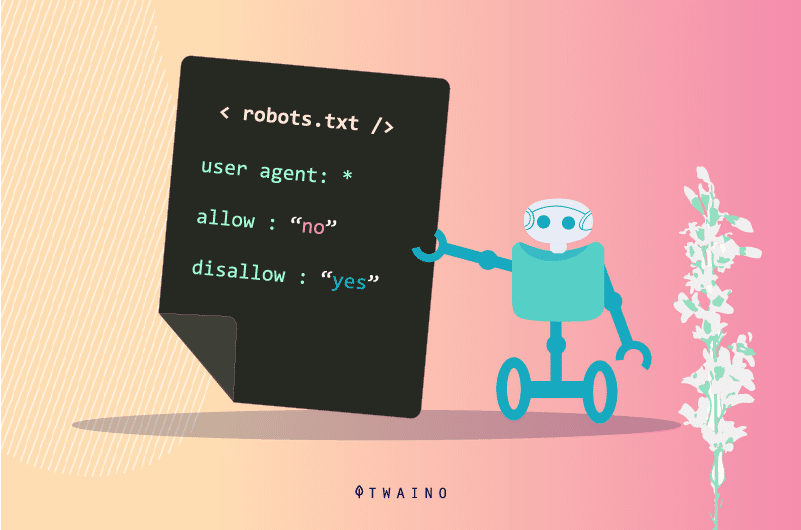
It may also have difficulty understanding the semantic implications of a sentence, such as undertones and connotations.
Also, ChatGPT may have difficulty understanding semantic nuances, such as distinctions between similar words or synonyms, or nuances of meaning between words.
3.4.4. ChatGPT’s limitations in text generation
This AI has several limitations when it comes to text generation. These include problems of originality and creativity.
Indeed, while it is capable of generating text from scratch or from a given source, it can be difficult for ChatGPT to generate text that is truly original or creative. It may in fact generate text that is similar to existing text and lacks originality.
In addition, it is possible for the generated text to contain grammatical or syntactical errors, especially when the text is generated from an imprecise or poorly worded prompt.
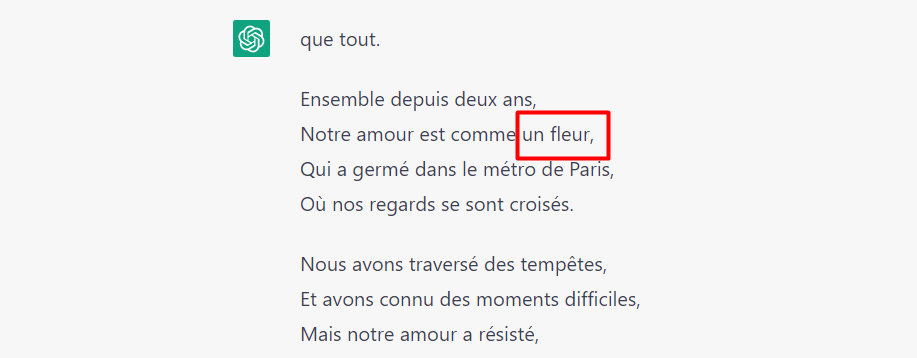
3.4.5. ChatGPT’s limitations in data understanding
The first limitation of this AI with respect to data is the understanding of structured data. While it can handle structured data such as tables or graphs, it may have difficulty understanding all the nuances and relationships between data.

ChatGPT may also struggle with understanding the specific contexts in which data is used, such as medical, financial, etc.
When dealing with large-scale data, the tool may have difficulty processing it due to memory or computational limitations. When the data is incomplete or erroneous, it can lead to inaccurate results.
3.4.6. ChatGPT’s limitations in understanding private information
While ChatGPT can handle some private information, it has limitations in understanding data of this nature.
For example, the AI may have difficulty understanding the legal and ethical implications of handling private information and its use.
The same is true for understanding the specific contexts in which private information is used and the rules associated with it.
To some extent, ChatGPT AI may have difficulty dealing with sensitive data such as health information, privacy, finances, etc.
Since it is important to protect private information from unauthorized access or data leakage, it is not advisable to attempt to process such information with this tool.
In fact, OpenAI states that it has access to users’ conversations with ChatGPT to verify that AI is being used in accordance with its policy.
Chapter 4: 10 Applications of ChatGPT – How to Use and Benefit from AI
There is no need to point out the importance of ChatGPT for both freelancers and businesses. If you are already using this AI, it’s time for you to harness its potential to increase your productivity and generate more revenue.
Although ChatGPT can be used in 1,000 ways, in this chapter we will discover some use cases for this AI and how it can assist you in your tasks.
4.1. Using ChatGPT to provide customer service
The ChatGPT AI can handle some customer service tasks, which will allow your team to handle the most complex occupations of your users.
In fact, it can be used to create chatbots and conversational agents that can capture and respond to customer queries in a more natural and human-like way.
This will involve installing the ChatGPT API on your site to leverage its ability to hold a dialogue in natural language.
This can help improve the overall customer experience, reduce the need for customer service representatives and increase efficiency.
In addition, ChatGPT can generate answers to frequently asked questions from customers and have them published on your site.
This will allow customers to find answers to their questions faster without having to wait for answers from a customer service agent.

In addition, you can also leverage ChatGPT’s translation capability to allow your customer service agents to communicate with customers who speak different languages than the company’s.
4.2. Creating content with ChatGPT
Another reason ChatGPT is a hit with web content creators is its ability to generate text, such as articles, stories and poetry.
This AI can be fine-tuned to work on a specific genre or style of content.
4.2.1. Article writing
This is one of the main use cases for ChatGPT. It was discovered that CNET already uses this AI to create more than 73 articles on its site without revealing to its users that the texts came from ChatGPT.
In other words, this artificial intelligence can be used to write blog posts without your visitors noticing.
It should be noted, however, that ChatGPT AI is not capable of writing all the content for you. Maybe the AI will be able to do it one day!
But right now, ChatGPT can be considered a writing assistant, rather than a writer. Now that’s a phrase that will make web writers happy! 😜

Indeed, a search engine optimized blog post that is likely to rank higher in SERPs must be quite detailed and fully satisfy the search intent of users.
Since ChatGPT is an automatic template, it generates sentences of the same format for different sections. Also, due to its various limitations, it can generate irrelevant text or even text with false information.
The best way to use this AI for writing is to start by asking it to explain your writing topic.
You can then ask it to suggest the main lines you can cover in your content. Then think about comparing these headlines with those proposed by other sites that have addressed the same topic.
This way, you will be able to establish a complete plan for your article so that it takes into account the aspects that others have not covered.
After that, you can start generating each part while providing it with key information that you want it to take into account.
After that, you can edit the texts that ChatGPT has generated and check the information it has provided.
4.2.2. Rewriting
If you have texts to rewrite, you can ask ChatGPT to do it for you. For that, it is enough to make a request like: rewrite me this text “the text” or write me a text similar to this “the text”.
4.2.3. Write a book and have it published online
One of the popular use cases for ChatGPT is to write an e-book and sell it on sites like Amazon.

The process is no different than the one we presented for writing articles. For illustrative purposes, we’re going to ask the AI to write us a book on “10 surefire strategies to get first on Google”.
To do this, we will start generating the main chapters of your future book. Then, we would only need to generate each part.
You can do the same and create books that you can sell and generate passive income.
4.2.4. Write scripts for your YouTube videos
ChatGPG can be used to write scripts for YouTube videos. In fact, it can help structure your story, develop characters and dialogue, and include information relevant to your target audience.

All you need to do is provide him with detailed information about the subject of the video, the target audience, and the tone you want to adopt for your script. They can even optimize the script to maximize the visibility of your video.
4.2.5. Use ChatGPT for copywriting
ChatGPT can be used for copywriting. This AI will be able to generate catchy titles, product descriptions, advertisements, video scripts, etc.
However, it is important to note that copywriting requires creativity and a good understanding of the target market and trends.

Therefore, it is important to proofread and edit the content generated by the template to ensure that it is relevant, compelling and engaging to the target audience.
You get the idea, ChatGPT is useful for creating a variety of content, it’s up to you to be creative in how you query with AI.
4.3.6. Use ChatGPT to answer emails
If you don’t have much time to answer your emails? No problem, ChatGPT can take care of it.

Simply paste the email you want to follow up on into the tool and ask it to respond to the email. Consider adding a sentence in your request to instruct the AI on what information it should include in its response.
By doing this, you are sure to get a highly personalized response that matches how you might respond.
4.3.7. Use ChatGPT to get ideas for content creation
If you’re lacking new ideas for creating content on your blog, YouTube channel or populating your social networks with engaging content, ChatGPT is what you need.
Just tell it your editorial line and your niche and the AI will generate content ideas. As an example, we will submit two queries to get ideas for content creation.
Query 1: Give us 10 blog post ideas about artificial intelligence. The articles will be published on an SEO site.
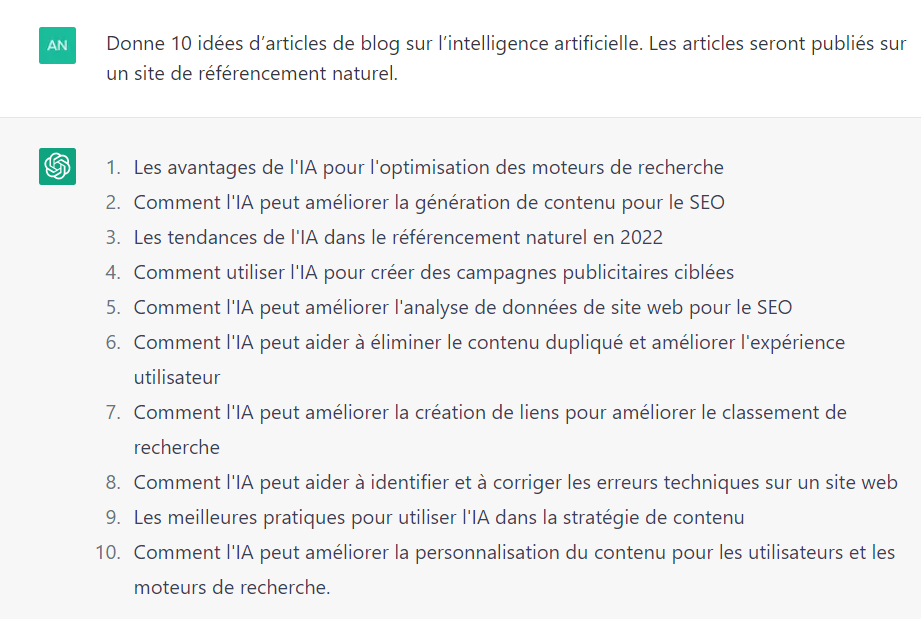
Query 2: Give 10 YouTube video topics on online content creation. Give only the topics that are currently popular.
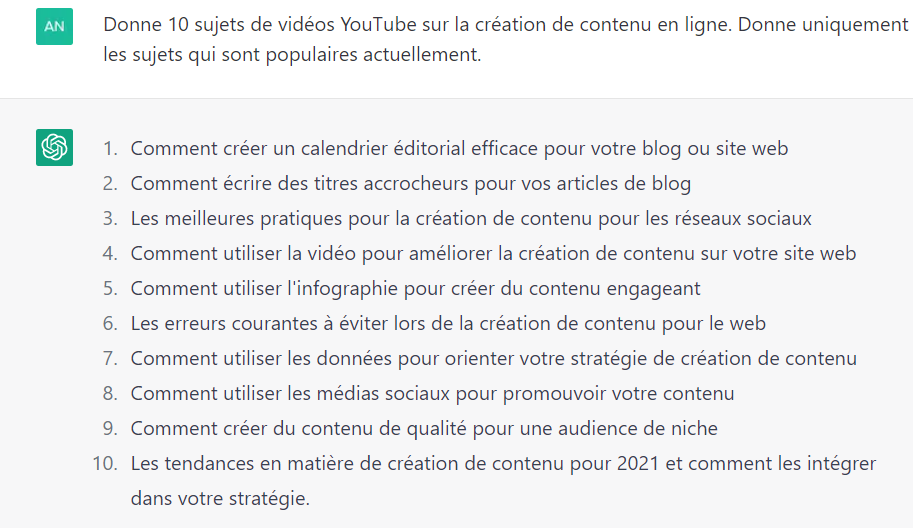
4.3.8. Use ChatGPT to generate content for your social accounts
ChatGPT can generate content for social networks that can be used to strengthen your site’s social media presence and improve your online visibility.

4.3.9. Use ChatGPT to write poems
If you like writing poems, you’ll love ChatGPT. This is because it also generates poems from a text it receives.
Let’s say you want to write a poem to celebrate your second birthday with your partner. We will ask the AI to write this poem for us from the following query:
“On the 2 year anniversary of my fiancée and I’s union, suggest a poem to celebrate this union. My partner’s name is Anne and mine is Jean. We met in a subway in Paris. We broke up once, but we got back together because our love is stronger.
And this is the magic of ChatGPT! 😅
“Together for two years,
Our love is like a flower,
That sprouted in the Paris subway,
Where our eyes met.
We’ve been through storms,
And have known difficult moments,
But our love has endured,
For it is stronger than all.
We have laughed, we have cried,
And we have grown stronger,
Together we are a team,
And our love only grows.
Anne and Jean, hand in hand,
We celebrate our two years,
And we promise each other,
To continue to love each other,
For all eternity.”
4.3.10. Use ChatGPT to create content for paid advertising
ChatGPT can generate content for paid ads that can be used to improve the performance of your online advertising campaigns.
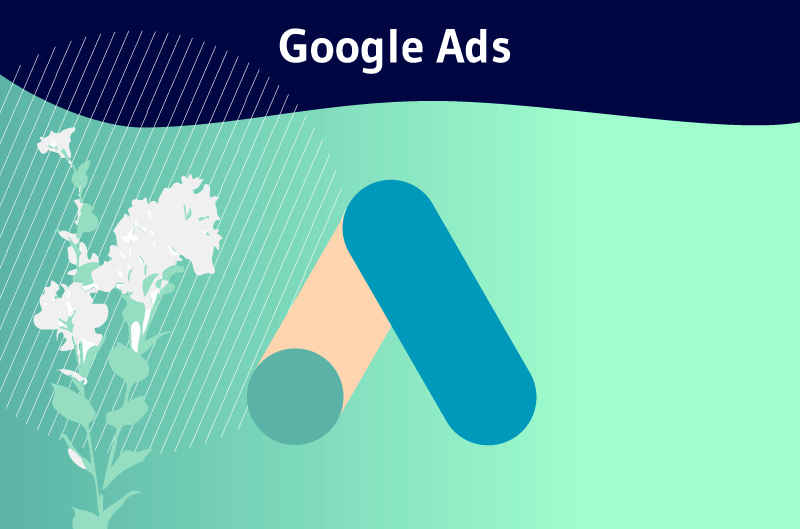
Whether it’s for SEA or social media advertising, this AI is effective in reaching your audience with content.
4.4. Use ChatGPT to generate documents
ChatGPT can be used to generate documents like reports and presentations. You only need to provide it with key details.
For example, you might ask ChatGPT, “Can you generate a report for me on the half-yearly sales figures of Company X?”
But it’s not just about generating a simple report, ChatGPT can also help create various types of documents such as user manuals, contracts, cover letters and more.
Using ChatGPT’s advanced features, you can also customize and adjust the generated documents to your specific needs.
The ability to generate professional-quality documents in a short amount of time and efficiently, without having to spend hours writing them, is truly an incredible asset for individuals looking to improve their productivity.
4.5. Use ChatGPT for advanced code generation and debugging
ChatGPT can be used to not only generate working code, but also to perform advanced debugging using common bug recognition techniques and problem solving algorithms.
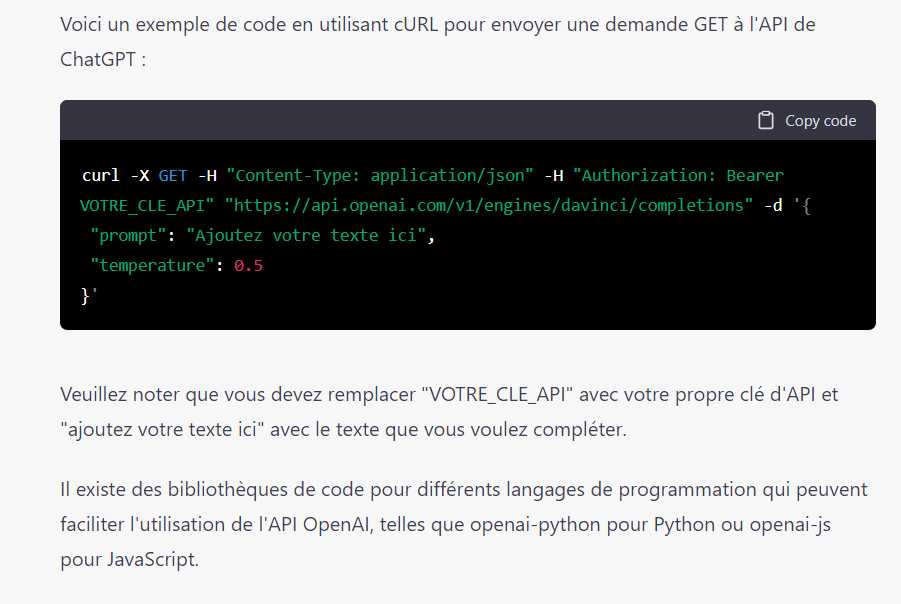
By providing detailed specifications of the desired functionality, ChatGPT can generate efficient code that is optimized to meet performance and quality requirements.
In addition, ChatGPT can be used to identify common coding errors, such as syntax errors and memory problems, and provide suggestions for correcting these errors.
For example, you can ask ChatGPT, “Can you generate a sort function to sort a list of data using the fast sorting algorithm, and also identify any performance problems in the existing code?”
As an example use case, you can use ChatGPT to create classic online tools. For example, you can ask the AI to generate code for you for a site that will automatically convert the cost of Bitcoin into a particular currency.
4.6. Use ChatGPT to find tutorials
Want to find tutorials faster? ChatGPT can generate tutorials by providing a detailed description of the task or technique to be taught, as well as all the information needed to make the tutorial clear and complete.
Even if the AI is not able to show you a video or screenshots, it presents its tutorials in an interactive and easy-to-follow manner.
That said, if the tutorial you need requires visual content, it’s best to take a look at YouTube tutorials.
4.7. Use ChatGPT as your personal coach
Granted, it goes a bit further, but ChatGPT can be your personal coach, whether it’s for motivation, finance, seduction, etc.

While it’s important to work with an expert, AI is capable of providing information and advice on a variety of topics. You can ask it for advice on your concerns and get tailored advice.
And since we remember things more experientially, we’ll ask ChatGPT to give us advice on waking up early.
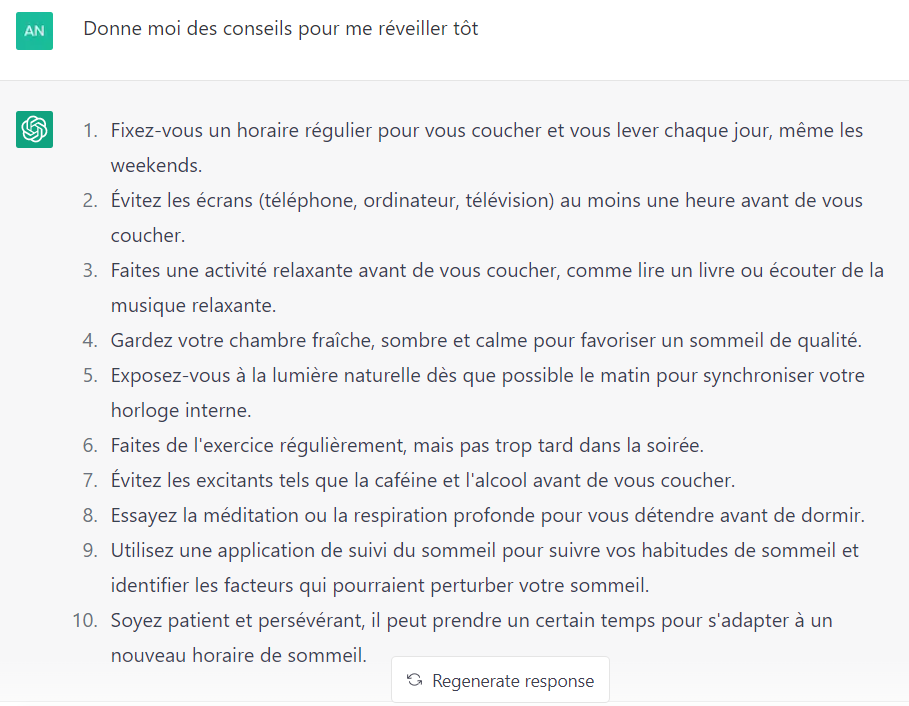
Similarly, you can ask the AI for help with your finances. All you have to do is submit your income and expenses and ask it for advice.
4.8. Use ChatGPT to become a professional on freelancing platforms with minimal effort
You can now become a professional on freelancing platforms like Comeup, Fiverr or Upwork.
As a first step, AI can help you generate effective and compelling service descriptions and profile descriptions.
ChatGPT can also help you identify the most sought-after skills and adapt your profile accordingly.
Moreover, it can assist you with order fulfillment, which will result in less effort on your part.
You can register on freelance platforms as a writer or translator and your task will only be to edit the proposals of ChatGPT.
4.9. Become a ChatGPT consultant
It’s obvious that many companies or professionals will look to leverage ChatGPT to perform some of the tasks that humans used to handle.
But it’s not as simple as that given the limitations of this AI that we discovered earlier.
To properly operate this tool, it is necessary for a human to step in to refine the queries to get exactly the answers you want as well as to edit ChatGPT’s work.
As a ChatGPT consultant, you can assist those professionals and companies who want to add ChatGPT to their process to increase their productivity.
As shown in the screenshot below, several people are already offering their expertise on the use of ChatGPT on the famous 5euros platform renamed Comeup.
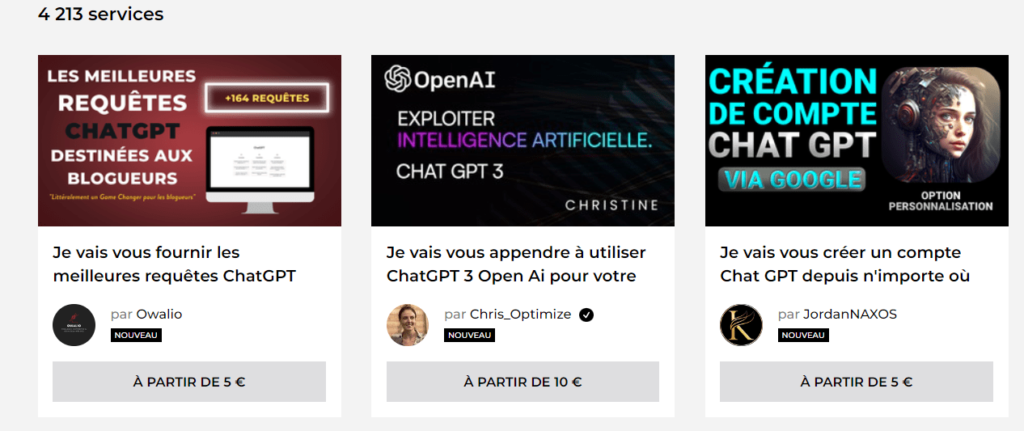
All you need to do is to master all the contours of this AI in order to really help those people who will need to use this AI. Bookmark this guide for quicker reference when you need it.
4.10. Use ChatGPT to discover security holes
Since ChatGPT processes code, you can have it analyze your site’s source code for security holes on your site.
To do this, you simply submit the source code and run the query. If you don’t do this to fix security flaws on your site as soon as possible, malicious people may do so and harm you.
Chapter 5: Using ChatGPT for SEO
ChatGPT can be used in some areas that were once reserved for experts. This is the case with SEO where this AI can give you a great support.
5.1. Use ChatGPT for keyword research
It can be used to discover keywords that you can incorporate into your content. All you need to do is to use some prompts to generate relevant key phrases and expressions for a given topic.
You can combine prompts with parameters to customize your query. For example, with the “n” parameter, you can generate a specific number of keywords.
As an example, we can ask ChatGPT to give us the top 20 keywords that we can include in a content with the title: “AI-generated text detection”.
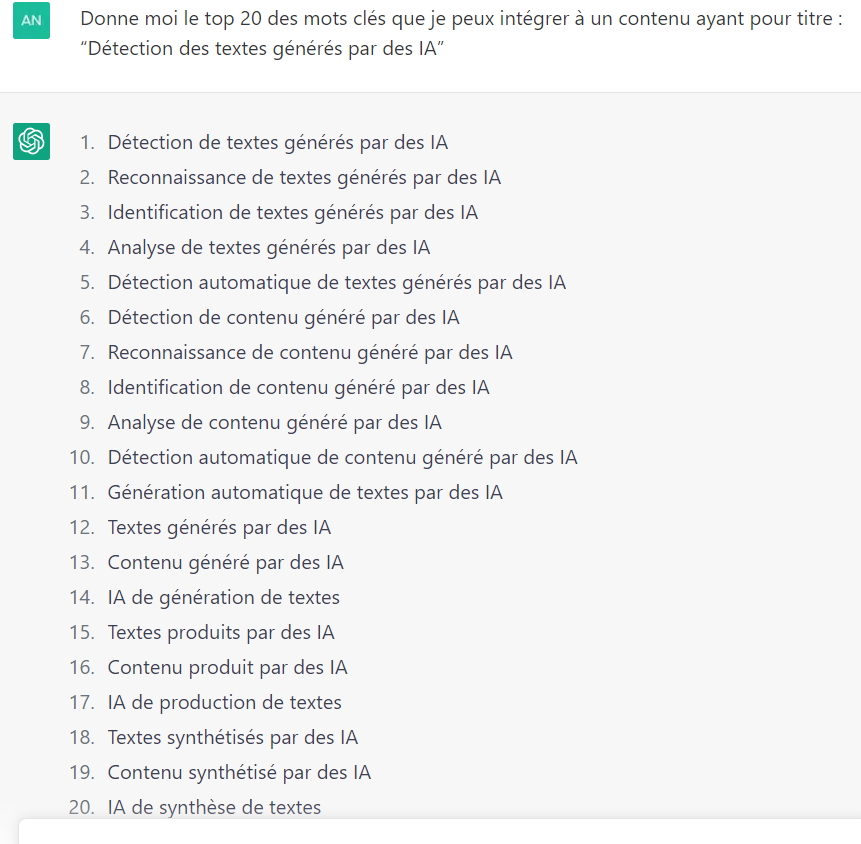
You can also do the same thing with the topics of your choice. However, it is important to check these keywords for you that they are relevant to your content.
Note that ChatGPT can also help you find terms closely related to your keywords. Indeed, these terms called Latent Semantic Indexing keywords allow search engines to understand your content in depth, and thus help your SEO.
For example, we can ask the AI to find us the terms closely related to the text analysis.
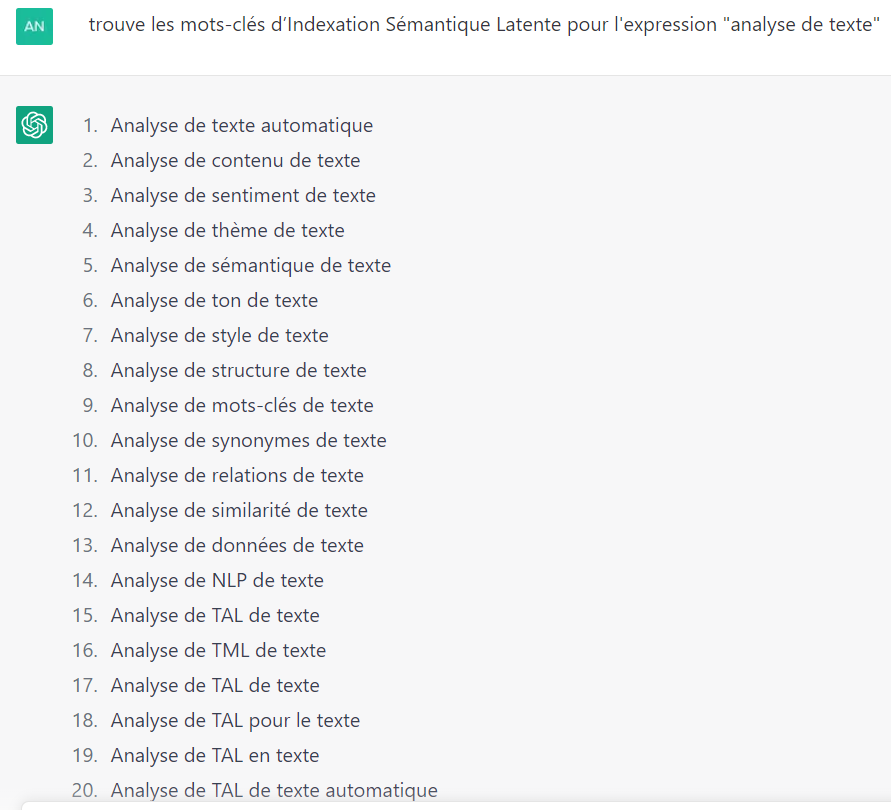
5.2. Use ChatGPT to generate catchy titles and meta descriptions
ChatGPT can also help write catchy titles and descriptions for your pages, which will be used by search engines to display your site in search results.
All you have to do is provide a short description of your article and it will come up with titles and meta descriptions for you.
You can even ask it to respect a certain number of characters since these tags have a limited number of characters.

If the title is untouched and actually has less than 60 characters (precisely 55), we realize that the AI has not respected our rule for the meta description, hence the interest to always check its answers.
We can still ask it to respect our rule of the maximum number of characters for the meta description. And this is what it does!

5.3. Use ChatGPT to generate a list of arguments or pros and cons
As you know, Internet users are fond of list-type articles as well as articles that highlight pros and cons. ChatGPT can help you create these types of content on your site.
Let’s first see how ChatGPT can generate a list of arguments for us.
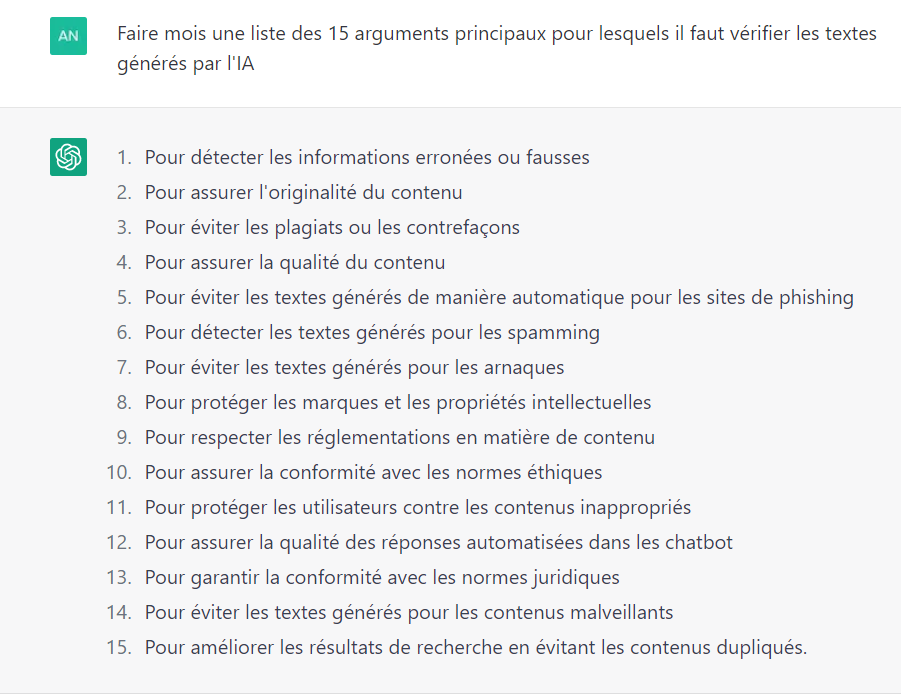
Now we’ll ask our wizard to suggest some pros and cons of AI-generated text. 😜
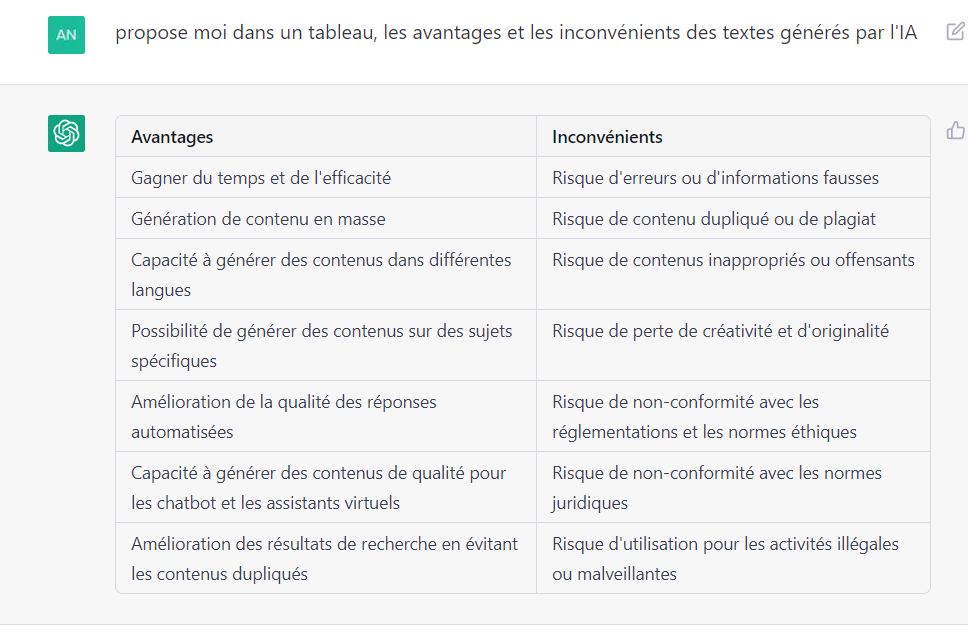
5.4. Use ChatGPT to find questions about a topic
Want to find questions about a topic to make an article or FAQs? ChatGPT will satisfy you. For this, you can use the “prompt” command to tell ChatGPT to generate questions using the specified topic.
Simply type “prompt: What are the most common questions about [topic]?” or “prompt: Generate questions about [topic]”.
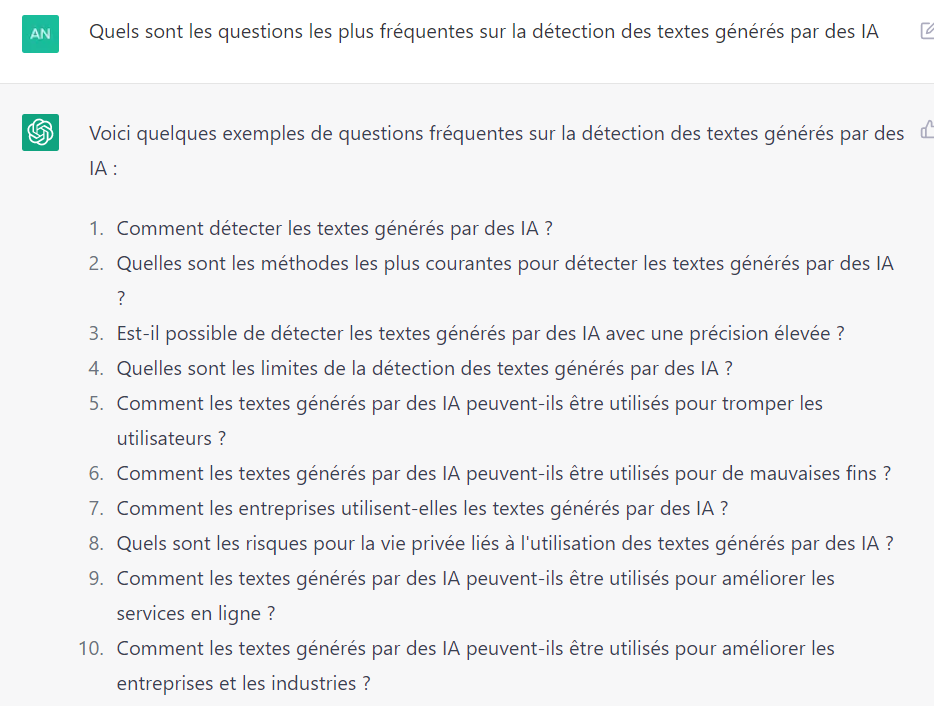
5.5. Use ChatGPT to find the issues a target audience has about a given topic
Without properly identifying your target audience’s issues, you won’t be able to provide them with tailored content and offers.
The good news is that ChatGPT can help you find out what your target audience’s issues are on a given topic. You can do this in these 4 simple steps:
- Define the target audience and the topic in question.
- Use ChatGPT to generate phrases and questions about the topic using prompts like “What are [target audience]’s main concerns about [topic]?”
- Use ChatGPT to respond to the generated questions using prompts such as “Give examples of issues [target audience] is facing regarding [topic].”
- Analyze ChatGPT responses to identify recurring issues and trends.
Note that you can still refine these steps based on what you are looking for, this is just a starting point for finding your audience’s concerns.
5.6. Use ChatGPT to group keywords into thematic clusters
ChatGPT can semantically analyze a corpus of text on a given topic to identify the most frequent keywords in that corpus and group them into thematic clusters based on their semantic relevance.
To use ChatGPT to group keywords into thematic clusters, you will first prepare your text corpus. Then submit your corpus to the AI and ask it to group keywords into thematic clusters.
These clusters will then allow you to identify the most important themes and the most frequent questions about your target topic. You can use the ChatGPT AI to generate titles for each resulting cluster.
5.7. Use ChatGPT to cluster your keywords by associated search intent
Online content is intended to satisfy a search intent. You need to know which keywords are associated with the search intent you want to satisfy in your content.
You don’t have to worry about this because ChatGPT is smart enough to group your keywords by search intent.
You just have to submit your list of keywords with a prompt like: “group me these keywords by search intent such as: informative, commercial or transactional.
5.8. Use ChatGPT to generate a list of facts and statistics with their sources
Facts and statistics allow you to create compelling introductions and support the points you make in your content.
Instead of scouring the web for facts and statistics to include in your text, you can save a lot of time by asking ChatGPT to do it.
For example, we’ll ask it to generate facts and statistics related to AI-generated content with their sources.
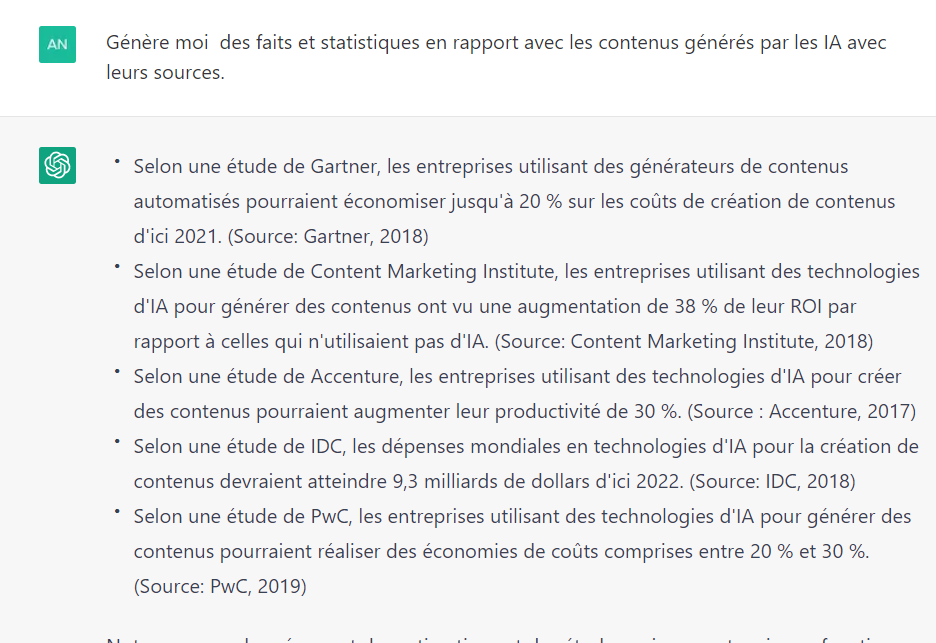
5.9. Use ChatGPT to generate structured data
Since ChatGPT generates code, it can help you generate structured data for your site.
Simply customize your prompt by defining the desired data fields and data structures.
5.10. Content analysis and SEO permanence
ChatGPT can also be used to analyze a website’s existing content to identify relevant keywords that are already being used, and then use them to strengthen future keyword research efforts.

You can also use AI to analyze your site performance data to identify SEO opportunities. Simply provide it with your performance data and the tool will help you analyze and interpret it.
Chapter 6: How to detect ChatGPT text
With the realism that ChatGPT exhibits, it’s very difficult to discern text that the AI has generated from that of a human. Fortunately, it is possible when you use tools that allow you to check whether text is specifically generated by ChatGPT.
In this chapter, we’ll learn about these tools that can help you detect whether text is from ChatGPT.
6.1. OpenAI GPT-2 Output Detector Demo
OpenAI GPT-2 Output Detector Demo is an online tool from ChatGPT’s parent company, OpenAI, for detecting whether text was generated by the GPT-2 model.
It uses a neural network to evaluate the similarity between a given text and texts generated by the GPT-2 model.
It can be used to detect texts generated automatically with ChatGPT, such as:
- Blog posts;
- Newspaper articles;
- Messages on social networks.
This tool is useful for people who want to verify the authenticity of online content and avoid spreading automatically generated content.
To use the tool, you must first visit the GPT-2 Output Detector demo page on Huggingface, the domain that hosts the tool.
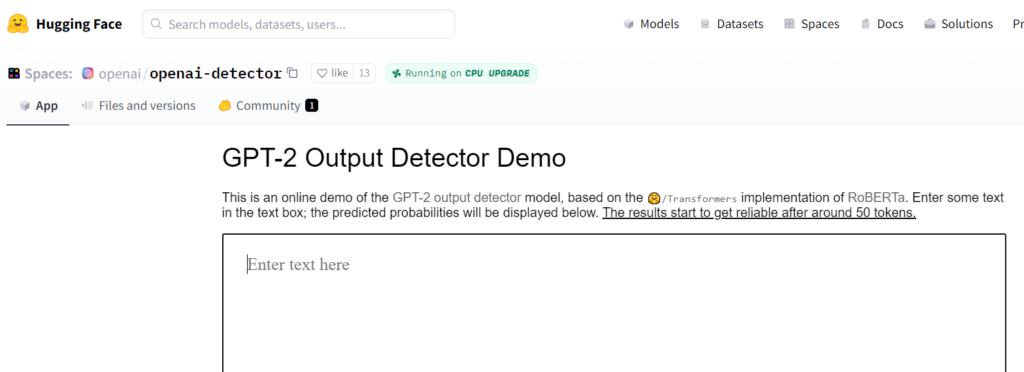
Once on the page, you can type or paste a text to submit it for analysis. The tool will analyze the text and give you an auto-generation probability score.
The higher the score the tool shows, the more likely the text was automatically generated by GPT-2.
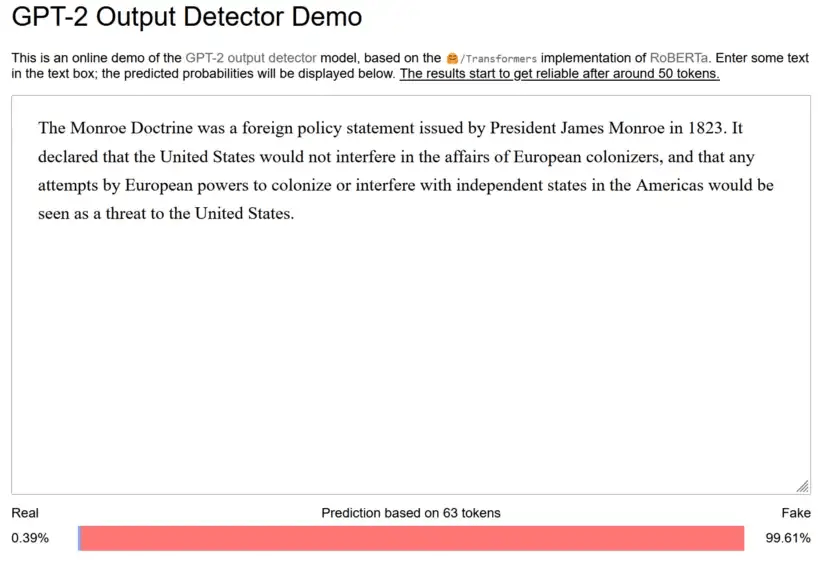
Source : medium
It is important to note that this tool is not infallible and does not guarantee 100% authenticity of submitted texts. It is therefore important to continue to check the generated texts to ensure that they are authentic and appropriate.
6.2. The GPTZero Tool
Developer Edward Tian recently unveiled an innovative tool called GPTZero that was launched on January 2, 2023. This tool is designed to detect text generated by language processing models like GPT-2.
It focuses on two key aspects: “perplexity” and “burstiness”. Perplexity measures the probability that each word is suggested by an automatic language processing model, whereas a human would tend to be more random in his word choices.
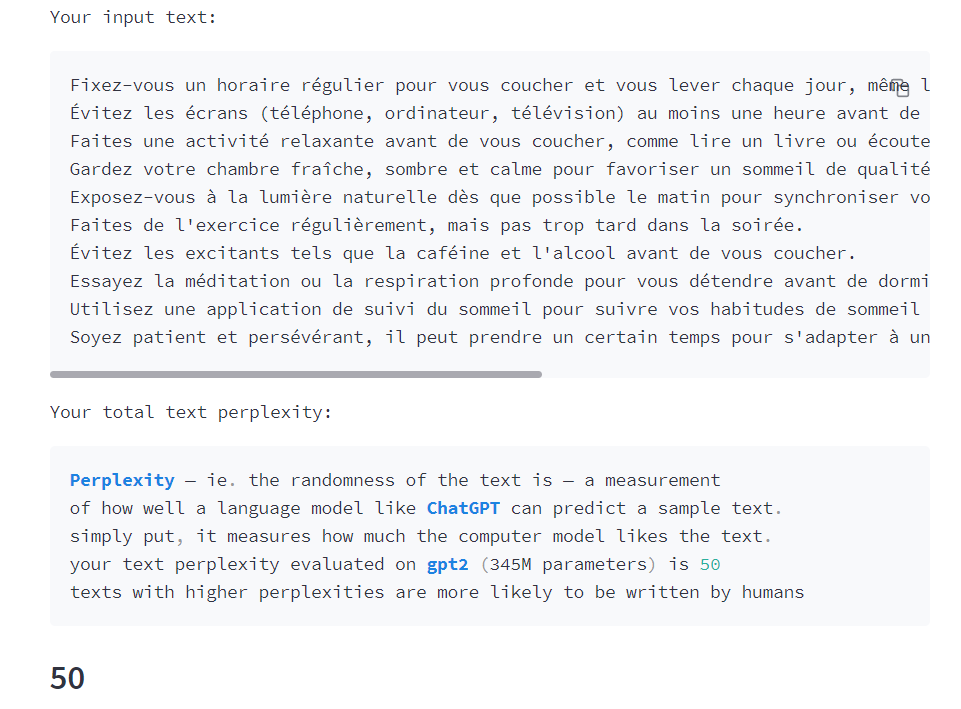
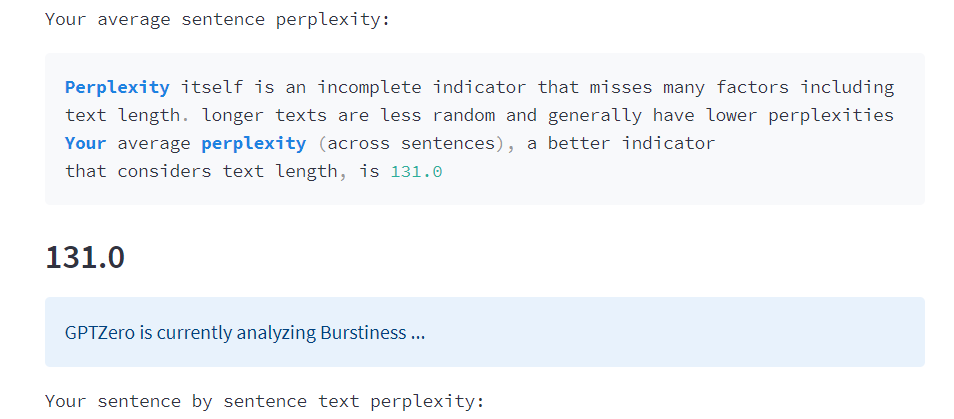
Burst, on the other hand, measures the peaks of perplexity in a sentence. Language processing models tend to have similar degrees of perplexity from one sentence to the next, whereas a human would likely write with spikes – perhaps a long, complex sentence followed by a shorter sentence.
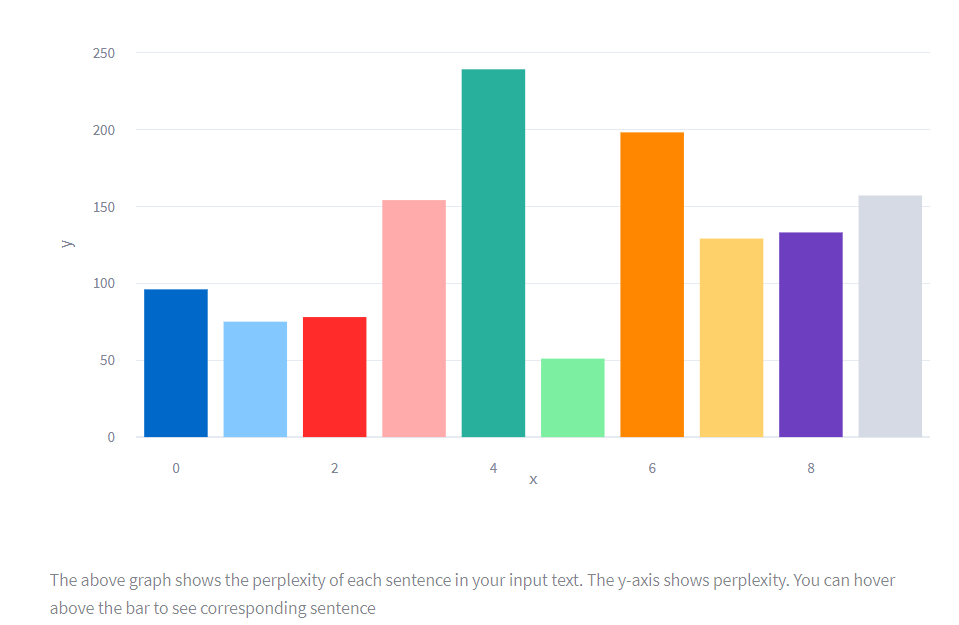
To test this tool, we will copy text, a text into the tool to see how it detected automated writing.
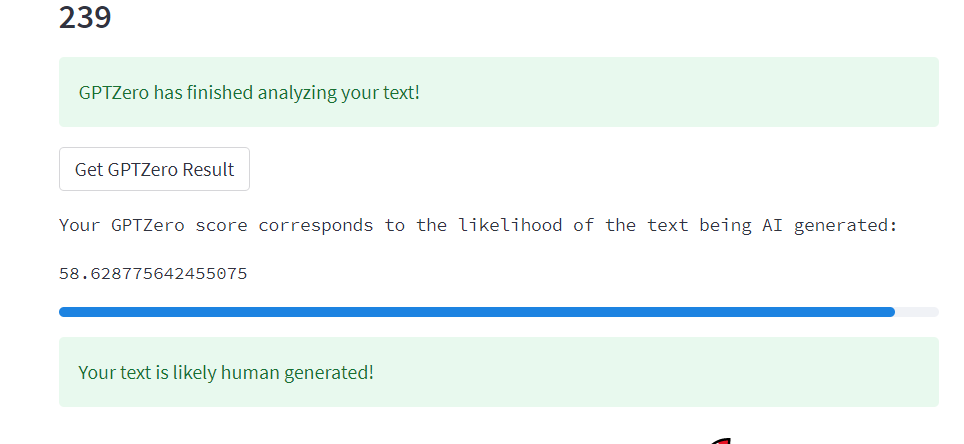
❓FAQ:
What does ChatGPT do?
ChatGPT is an AI that communicates with you like a human. It interacts with humans to answer questions and makes suggestions to help solve problems.
What are the benefits of ChatGPT?
ChatGPT offers a variety of features to help you interact more intelligently with it. It can help you find answers to your questions, better understand the context, and improve the accuracy of the information provided. It can also help you make faster and more effective decisions.
How to register with OpenAI to use ChatGPT
To register on OpenAI and use ChatGPT, you need to follow these steps:
● Access OpenAI
● Click on the “Register” button at the top ;
● Fill out the registration form with your name, email address and a password
● Agree to OpenAI’s terms of use and privacy policy
● Then choose “Register” to submit your application
● Check your mailbox to confirm your registration;
● Simply click on the link in the email to activate your account
● Log in now using your credentials.
Once logged in, you can access ChatGPT and start running your queries.
How does ChatGPT work?
ChatGPT is an automatic natural language processing model based on the Transformer, a neural network designed to process data sequences.
It uses machine learning techniques to understand and generate text using prompts (sentences or phrases) as a starting point. It is able to understand context and generate relevant and consistent responses.
What are the limitations of ChatGPT?
ChatGPT is a very powerful automatic natural language processing model, but it has some limitations. It can sometimes generate responses that are inconsistent or not relevant to the prompt.
It can also have difficulty understanding certain linguistic nuances or generating text in very specific domains.
It may also reproduce biases or prejudices it learned from the training data. Therefore, it is important to monitor and review the results generated by ChatGPT to ensure that they are relevant and appropriate.
How can I be sure that ChatGPT is providing me with correct answers?
ChatGPT is an AI tool that can be used to obtain answers to queries or instructions on a variety of topics.
However, it is important to note that ChatGPT is not connected to the internet and can sometimes provide incorrect answers or harmful instructions.
This is due to the fact that the AI has no knowledge of the world as well as the events that will occur from 2021 onwards. Thus, it is not obvious that it can provide you with relevant information about IT that is published on the web after 2021.
It is important to use AI with caution and always check the information provided by ChatGPT to make sure it is correct and reliable.
How much will it cost me to use ChatGPT?
ChatGPT is currently free to use, as it is still in the testing phase. However, it is important to note that once ChatGPT is available for commercial use, there will certainly be costs associated with its use.
These costs may vary depending on how you use it, how often you use it, and how much data you want to generate.
There may also be additional costs for advanced features or for using ChatGPT for commercial purposes.
Therefore, it is important to watch for updates and announcements from OpenAI for information on future costs for ChatGPT.
Who can see my conversations?
The OpenAI team. By using ChatGPT, you agree to have your conversations analyzed by the OpenAI team to ensure quality and compliance with OpenAI policies and security requirements.
However, please be aware that your conversations are protected by strict confidentiality and will not be shared with anyone outside the OpenAI team without your consent.
Does plagiarism detection software detect text generated by ChatGPT?
No. ChatGPT generates original text and does not copy web pages. Since the texts it generates come from the AI and are not yet published on a web site, the detection software cannot detect it.
However, it can happen that some sentences proposed by ChatGPT are detected by these software.
Is it possible to detect the texts generated by ChatGPT
It is possible to detect ChatGPT generated text by using plagiarism detection tools or by comparing the text to known ChatGPT generated text.
It is also possible to detect specific stylistic or content characteristics that may be associated with the use of ChatGPT.
How do I contact customer service?
You can contact OpenAI, the parent company of ChatGPT, through their customer service department by phone at +33 01 02 03 04 05, by email at contact@example.com or via an online contact form.
Are there other AIs like ChatGPT?
Yes, there are other natural language processing models similar to ChatGPT. For example, there is GPT-2 from OpenAI, BERT from Google, and RoBERTa from Facebook, Jasper AI, etc.
These models all use machine learning techniques to understand and generate text, but they have unique architectures and capabilities.
There are also other AI models that can be used for specific tasks such as natural language understanding, text generation, sentiment analysis and more.
In summary
It is worth remembering that ChatGPT is an automatic natural language processing model that is useful for a variety of tasks such as:
- Automatic text generation;
- Translation; and
- Sentiment analysis
- Question solving;
- Language understanding;
- Code generation.
It can also be used to create chatbots and conversational agents, automatic content, video scripts, automatic email responses.
However, ChatGPT has limitations in text generation, data understanding, private information understanding, semantic understanding, social and cultural context understanding.
While this AI can help web editors by generating texts automatically, it cannot yet completely replace web editors, as they have specific skills and knowledge that it lacks.
To use ChatGPT, you need to define your goals and use the settings and commands discussed in this guide to control the nature of the responses generated. If you want to learn about other AIs for writing content, you can check out our guide to Jasper.


